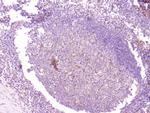Search Thermo Fisher Scientific
图: 1 / 3
CD1b Antibody (PA5-95541) in IHC (P)



产品信息
PA5-95541
种属反应
宿主/亚型
分类
类型
抗原
偶联物
形式
浓度
纯化类型
保存液
内含物
保存条件
运输条件
RRID
产品详细信息
Reconstitute with 0.2 mL of distilled water to yield a concentration of 500 µg/mL.
靶标信息
This gene encodes a member of the CD1 family of transmembrane glycoproteins, which are structurally related to the major histocompatibility complex (MHC) proteins and form heterodimers with beta-2-microglobulin. The CD1 proteins mediate the presentation of primarily lipid and glycolipid antigens of self or microbial origin to T cells. The human genome contains five CD1 family genes organized in a cluster on chromosome 1. The CD1 family members are thought to differ in their cellular localization and specificity for particular lipid ligands. The protein encoded by this gene localizes to late endosomes and lysosomes via a tyrosine-based motif in the cytoplasmic tail, and requires vesicular acidification to bind lipid antigens.
仅用于科研。不用于诊断过程。未经明确授权不得转售。
篇参考文献 (0)
生物信息学
蛋白别名: BDCA1; CD1b; CD1B antigen, b polypeptide; CD1C antigen; cortical thymocyte antigen CD1B; differentiation antigen CD1-alpha-3; MGC125990; MGC125991; RP11-101J8.3; RP11-101J8.4; T-cell surface glycoprotein CD1b
基因别名: CD1; CD1A; CD1B; R1
UniProt ID: (Human) P29016
Entrez Gene ID: (Human) 910



